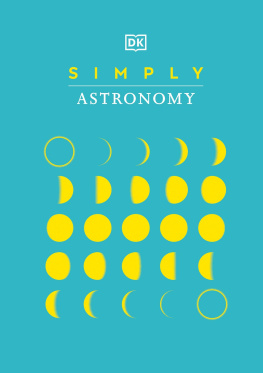The Cosmos
Astronomy in the New Millennium
Fifth Edition
The Fifth Edition of The Cosmos: Astronomy in the New Millennium provides you with the fundamentals of astronomical knowledge that have been built up over decades, with an expanded discussion of the incredible advances that are now taking place in this fast-paced field, such as New Horizons flyby of Pluto, exoplanets, dark matter, and the direct detection of gravitational waves by LIGO.
Written in a clear and easily understandable style, this textbook has been thoroughly revised to include (among other things) updated data and figures, new images from recent space missions and telescopes, the latest discoveries on supernovae, and new observations of the region around the four-million-solar-mass black hole at the center of our Milky Way Galaxy.
Jay M. Pasachoff , Field Memorial Professor of Astronomy at Williams College, teaches the astronomy survey course. He is also Director of the Hopkins Observatory there. He received his undergraduate and graduate degrees from Harvard and then had postdoctoral fellowships at the Harvard College Observatory and the California Institute of Technology, where he has also had recent sabbatical leaves. He now has a visiting appointment at the Carnegie Observatories.
He has observed 70 solar eclipses. He also studies occultations of stars by Pluto and other objects in the outer Solar System.
Pasachoff is Chair of the Working Group on Eclipses of the International Astronomical Union and was Chair of the American Astronomical Societys Historical Astronomy Division. He is also co-editor of Teaching and Learning Astronomy (2005) and Innovation in Astronomy Education (2008).
He received the American Astronomical Societys Education Prize (2003); the Janssen Prize from the Socit Astronomique de France (2012); and the Richtmyer Memorial Lecture Award, American Association of Physics Teachers (2017). Asteroid (5100) Pasachoff is named after him.
Alex Filippenko is a Professor of Astronomy, and the Richard & Rhoda Goldman Distinguished Professor in the Physical Sciences, at the University of California, Berkeley. He received his undergraduate degree from the University of California, Santa Barbara (1979) and his doctorate from the California Institute of Technology (1984).
His primary areas of research are exploding stars, gamma-ray bursts, active galaxies, black holes, and observational cosmology. Filippenko was the only person to have been a member of both teams that revealed the Nobel-worthy accelerating expansion of the Universe. He is one of the worlds most highly cited astronomers and was elected to the National Academy of Sciences (2009).
Filippenko has won many prestigious teaching awards, including the Carnegie/CASE National Professor of the Year among doctoral institutions (2006). He has appeared frequently on science newscasts and television documentaries, especially The Universe series. He received the Carl Sagan Prize for Science Popularization (2004). He enjoys world travel and observing total solar eclipses (16, all successfully).

An artists conception of two black holes, GW170104, as they merged, similar to the ones detected by the Laser Interferometer Gravitational-wave Observatory (LIGO).
Credit: LIGO/Caltech/MIT/Sonoma State (Aurore Simonnet)
The Cosmos
Astronomy in the New Millennium
Fifth Edition
Jay M. Pasachoff
Williams College, Massachusetts
Alex Filippenko
University of California, Berkeley

University Printing House, Cambridge CB2 8BS, United Kingdom
One Liberty Plaza, 20th Floor, New York, NY 10006, USA
477 Williamstown Road, Port Melbourne, VIC 3207, Australia
314321, 3rd Floor, Plot 3, Splendor Forum, Jasola District Centre, New Delhi 110025, India
79 Anson Road, #0604/06, Singapore 079906
Cambridge University Press is part of the University of Cambridge.
It furthers the Universitys mission by disseminating knowledge in the pursuit ofeducation, learning, and research at the highest international levels of excellence.
www.cambridge.org
Information on this title: www.cambridge.org/9781108431385
Jay M. Pasachoff and Alex Filippenko 2019
This publication is in copyright. Subject to statutory exception and to the provisions of relevant collective licensing agreements, no reproduction of any part may take place without the written permission of Cambridge University Press.
Fourth edition published in 2013. The previous edition ( The Cosmos, 3rd Edition ) was published in 2007 by Brooks/Cole Cengage.
Printed and bound in Great Britain by Clays Ltd, Elcograf S.p.A.
A catalog record for this publication is available from the British Library.
ISBN 978-1-108-43138-5 Paperback
Cambridge University Press has no responsibility for the persistence or accuracy of URLs for external or third-party Internet Web sites referred to in this publication and does not guarantee that any content on such Web sites is, or will remain, accurate or appropriate.
Contents
Detailed Contents

Asteroid trails, curved because of parallax across an image of a cluster of galaxies in Hubble Frontier Field Abell 370.

The James Webb Space Telescope being tested.

A double page from Galileos Sidereus Nuncius (1610) showing his engravings of the face of the Moon as seen through his newfangled telescope.

Mae Jemison and Sally Ride, NASA astronauts, in a 2017 LEGO set, in front of a Space Shuttle.

NASAs Cassini mission farewell image of Saturn and its rings. The image is the last full mosaic taken two days before the spacecraft plunged into Saturn.

Terrain on Pluto, a close-up from NASAs New Horizons.

Asteroid and dwarf planet 1 Ceres, imaged from NASAs Dawn spacecraft that is orbiting it.





















